|
|
|
|
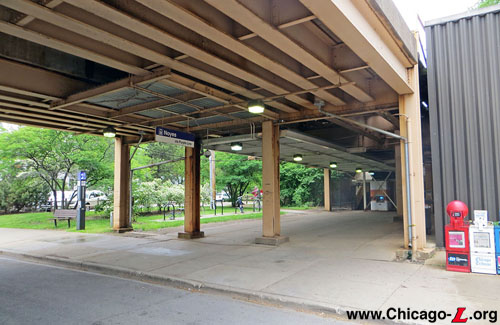
The entrance to Noyes station is seen looking northwest on May 29, 2015. For a larger view, click here. (Photo by Graham Garfield) |
.
|
|
|
|

The entrance to Noyes station is seen looking northwest on May 29, 2015. For a larger view, click here. (Photo by Graham Garfield) |
.
Noyes
(2225N/900W)
Noyes Street and Noyes
Court, City of Evanston
Service Notes:
Purple Line: Evanston
Quick Facts:
Address: 909 Noyes Avenue
Established: May 16, 1908
Original Line: Northwestern Elevated Railroad, Evanston branch
Previous Names: none
Skip-Stop Type: All-Stop
Rebuilt: 1931
Status: In Use
History:
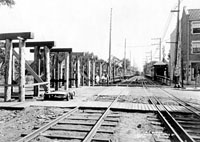
The original wooden station house at Noyes is seen looking south on August 10, 1928. The station was originally between the tracks, but was moved to the side and side platforms substituted as part of the phasing for the track elevation project, which has begun with the erection of the wooden trestle on the left. For a larger view, click here. (Photo from the CTA Collection) |
"L" service first entered north Chicago and Evanston by way of an agreement to use the tracks of the Chicago, Milwaukee and St. Paul Railway's tracks, replacing the steam service that the St. Paul had previously provided. The Evanston City Council authorized the electrification of the tracks of the Chicago, Milwaukee and St. Paul Railroad's tracks in their city in March 1907, but also required that the grade-level tracks be elevated between Howard Avenue at the south city limits and University Place at the north end of downtown by the end of 1910. "L" service north of Wilson to Central Avenue in Evanston began on May 16, 1908.
The St. Paul had a station at Noyes Avenue, of a style typical of railroad depots. As they did at the other stations on the newly electrified line, the Northwestern Elevated Railroad chose not to use the station facilities of the St. Paul steam railroad, which were situated and designed for the needs of a main line commuter railroad rather than a rapid transit service. Instead, the Northwestern built a new station at the same location as the St. Paul's station. The "L" station facility at Noyes was a simple ground-level station and modest platform. The station house was a small, wood frame building set between the two tracks at ground level with a wooden walkway and stairs leading up to it from the street. The exterior used clapboard siding and a hipped roof with eaves. The rear opened out onto an island platform. The platform had a short canopy with a hipped roof (which was actually a continuation of the station house's roof) and center wooden columns with angled brackets, and wood decking.
Track Elevation and a New Station
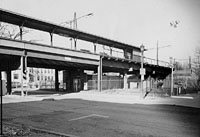
The north end of the Noyes station is seen looking northwest in October 1959. The temporary wooden station house provided access to the platform via what was intended as an auxiliary exit. For a larger view, click here. (Photo from the Graham Garfield Collection) |
The Evanston City Council had always wanted the line through the city elevated and separated from street traffic and pedestrians, but economics made it impossible to do all at once. The south half of the line, from Howard Street to University Place, was elevated first in 1910. The final elevation of the North Side Division tracks through north Evanston between University Place and the city limits at Isabella Street was ordered by the city council in 1920, but financing problems delayed the beginning of construction until 1928. Construction began in August and was a joint venture between the Chicago Rapid Transit Company (CRT), the North Shore Line, and the Chicago Milwaukee & St. Paul (who still owned the right-of-way). Trains were shifted onto a temporary two-level wooden trestle -- northbound trains on October 4th and southbound on December 9th -- with two-level stations while construction of the permanent solid-fill embankment progressed. Work was largely finished by 1931.
Foster and Noyes stations were rebuilt in 1931 at the same time as Central, when the line was elevated through north Evanston. There were Beaux Arts station houses that were similar to Central's designed for Noyes and Foster by Chicago Rapid Transit Company architect Arthur Gerber, but they were never built. Instead, there were "temporary" wooden station houses below the tracks at Noyes and Foster on the present sites of the walkways from the street to the stairs up to the platforms, across from where the permanent station houses would've been. These temporary station houses were removed in 1964, when the fare controls were moved up to platform level.
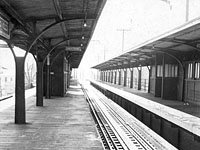
The Noyes platforms are seen looking south on February 11, 1957 -- the island platform for "L" trains and northbound North Shore Line interurbans, and the side platform for just southbound interurbans. The enclosures contained stairs to street level. For a larger view, click here. (Photo from the Graham Garfield Collection) |
The station originally had two platforms, one island between the two tracks and an additional side platform to the west of the inbound track. The island platform was for the "L" and northbound passengers of the North Shore Line, a interurban that entered Chicago via trackage rights on the Evanston and North Side "L" lines, while the side platform was for southbound North Shore Line riders. The idea was to separate inbound interurban passengers so that they couldn't transfer to local "L" trains for free. There were no such concerns about "L" passengers boarding northbound North Shore Line trains, as the interurban had conductors that would check for tickets. The platforms were originally decked with Haydite concrete slabs covered with 1"-thick asphalt planks. The island platform's steel canopy supports ran down the center line and split into gently-curving gull wing-shaped roof supports, supporting a wooden canopy roof. The side platform was similarly designed, except that the supports lined the back of the platform and simply arched out over the platform. The stairs were sheltered by wooden enclosures with swinging doors at the front of each enclosure.
Later Developments
The disused North Shore Line platforms at Foster, Noyes, and Central, which were abandoned when operation via the interurban's the Shore Line Route was discontinued in 1955, were not removed until 1970, although their concrete footings are still evident. The island platform is still in use by "L" trains, though its asphalt flooring was later replaced with a concrete deck.
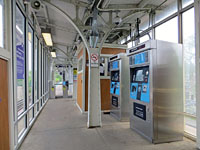
The platform-level fare controls at Noyes are seen looking south from the top of the stairs from street-level on May 29, 2015. Never intended to accommodate a fare control area, circulation here is tight but sufficient for the ridership levels the station typically sees. For a larger view, click here. (Photo by Graham Garfield) |
On July 16, 1964, the fare controls at Noyes were relocated to the far north end of the platform. The street-level wooden station house, which had been meant to be temporary (but lasted over 30 years) was demolished, and a single-agent booth was erected at the top of the stairs from street level. The width of the platform allowed for two lanes of passenger traffic, with the one farthest from the booth intended for exiting passengers and regulated by a one-way turnstile. The lane passing in front of the booth had no turnstile, with one not installed for many years.
On March 29, 1996, the northbound berth markers at Noyes station relocated to allow installation of Automatic Fare Control (AFC) equipment -- farecard vending machines and two turnstiles. Because the AFC turnstiles were wider than the ones they replaced, they had to be placed south of the agent's booth, encroaching further onto the platform and requiring train berthing to be moved farther south.
During spring 2004, Noyes began receiving new platform signage. The older KDR-type station name signs were replaced with new Green Line Graphic Standard versions. The thinner strap brackets that held up the previous signs were replaced with more substantial steel frames. Also replaced were the directional wayfinding/Board Here signs, the long signs directing passengers to which direction of service operates on which side of the platform, at the top of each stair to the platform. The first of the new station name signs and a few symbol signs were installed at the far north end of the platform at the same time. The rest of the station name signs, column signs, and directional signs were installed later.
In June 2005, new station entrance signs were added at street level. Two signs were hung over the sidewalk from the steel viaduct, one single-sided sign facing each direction suspended from each side of the bridge near the corners of the station house. The signs, conforming to a revised Green Line Graphic Standard design, provide the name of the station and the line serving it.
Noyes Gets 'Renewed'
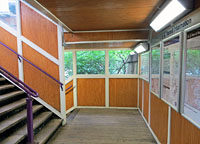
The mezzanine stair landing at Noyes station is seen looking west on May 29, 2015, following its refurbishment as part of the CTA's station renewal program in 2012. The sidewalls were replaced with new beadboard. Windows at the ends of the landing, closed up many years before, were reopened to allow more light in. The back wall on the right, originally just the plain concrete of the abutment wall, was covered with a curtain wall of beadboard for improved aesthetics. For a larger view, click here. (Photo by Graham Garfield) |
On September 20, 2011, Chicago Mayor Rahm Emanuel and CTA President Forrest Claypool announced a new CTA station renewal initiative designed to provide a facelift to 100 CTA rail stations over the following 12 months. The initiative, performed by work crews called the 'Renew Crew' comprised of different trade workers, focuses on providing repairs in a more efficient way, creating a cleaner, brighter and more appealing station that improves the customer travel experience. Different stations received different scopes of work depending on their needs and the available resources, but generally fell into two categories: basic renewals and expanded renewals.
Noyes received an "expended renewal' in Fall 2012, and as part of the work crews rehabilitated several parts of the station over a six-week period. To accommodate some extensive work at the entranceway and stairs, which are narrow and for which there is no alternative for platform access, the station was temporarily closed over the weekend of October 12-15, 2012.
Improvements at Noyes included paint removal and reapplication, power washing, gutter and drain cleaning, graffiti removal and lighting additions. Specific upgrades included bolstering the platform canopy structure, replacing rotted wood at the base of the customer assistant booth, replacing wooden windbreaks with steel ones, adding a bench, patching loose concrete on the platform, and clearing abandoned bikes and bike frames from racks at the street level. The steel canopy structure was primed and painted, including the columns and arched roof supports, and base plates. The canopy roofing, which was originally wood beadboard covered with asphalt roofing paper and tar, was replaced with a new corrugated metal roof. Deteriorated sections of corrugated metal roofing underneath elevated track structure were replaced, and paint touched up on the roofing. The wooden enclosure around the stairs from street level to the platform was replaced with new wood beadboard, left unpainted, and damaged lexan windows replaced. Long-covered windows were reopened, and wood cladding added to the rear wall of the stairs, which is actually the beginning of the concrete embankment. Lighting fixtures were relamped and cleaned.
Red-Purple Lines Modernization (RPM) Project
Due to the deteriorating condition of the infrastructure on the Red Line north of Belmont and on the Purple Line, the CTA initiated the Red-Purple Modernization Project (RPM) to bring the existing transit stations, track systems, and structures into a state of good repair. The project, which stretches along the existing Red and Purple lines from north of Belmont station to Linden terminal, would help bring the existing transit line into a state of good repair, reduce travel times, improve access to job markets and destinations, and provide improved access to people with disabilities.
The project began in 2009 with a vision study to assess the scope of needs and develop a set of alternatives for study. In 2010, in accordance with the National Environmental Policy Act (NEPA), CTA and Federal Transit Administration (FTA) initiated the environmental review process for the project and undertook work to develop an Environmental Impact Statement (EIS). The process included numerous public meetings and input opportunities, and study of various alternatives for achieving a good state of repair for the infrastructure in the project area.
A number of alternatives are under consideration for the RPM project, including the comprehensive reconstruction of track, stations, and structures along the line. The four options currently under consideration and study, not including an FTA-required "no action" baseline scenario, include:
The Modernization with Station Consolidation option includes the consolidation of Foster station with the Davis and Noyes stations by closing the existing Foster station and adding entrances to Davis and Noyes -- at Church Street for Davis station, at the north end of Davis station and approximately five blocks south of Foster station; and at Gaffield Place, approximately three blocks north of Foster station and one block south of Noyes station. The Modernization option, while including no station consolidations, also includes the addition of an auxiliary entrance to Noyes station at Gaffield Place.
Other alternatives considered earlier in the study but subsequently eliminated due to public comment and further study included basic rehabilitation without adding a transfer station at Loyola, a modernization option with only three tracks between Lawrence and Howard, and a modernization option with a 2-track subway under Broadway.
The full-scale modernization envisioned on the Red-Purple Modernization Project could cost anywhere from $2.5 to $5 billion. On February 8, 2012, the CTA board retained Goldman Sachs & Co. to lead the search for public-private partnerships to help finance the reconstruction, which has no firm date. Goldman Sachs will work with Chicago-based Loop Capital Markets LLC and Estrada Hinojosa & Co., but will accept no fee for the first year as it determines the ability to raise private capital.
See CTA's Red & Purple Modernization page for more information about the scoping and planning process, and the various alternatives being considered.
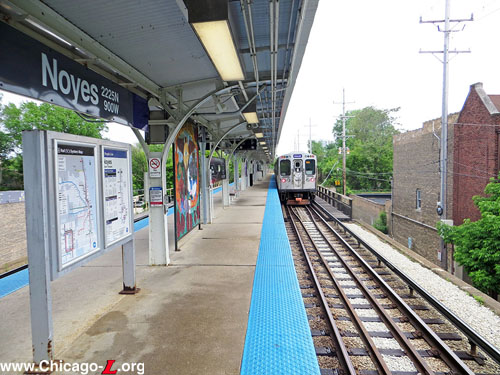
Noyes station's island platform is seen looking south on May 29, 2015. The gullwing canopy is typical of the stations built for the 1931 elevation project in north Evanston. The station signage was updated in 2005. For a larger view, click here. (Photo by Graham Garfield) |
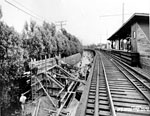 |
noyes02.jpg (244k) |
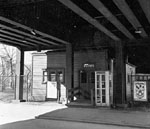 |
noyes04.jpg (126k) |
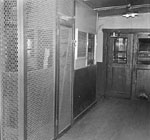 |
noyes05.jpg (147k) |
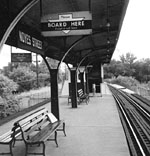 |
noyes07.jpg (115k) |
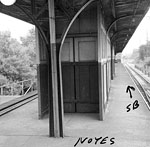 |
noyes08.jpg (101k) |
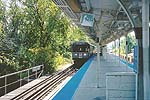 |
cta2838b.jpg (184k) A Linden-bound Purple Line train led by car 2838 heads into Noyes station, looking south on September 26, 1999. Note that the end of the platform is unfinished and blocked from passenger use. (Photo by Mike Farrell) |
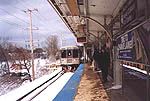
|
cta2848a.jpg (61k) |
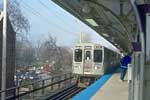
|
cta2689.jpg (111k) |
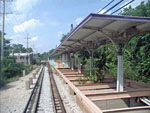 |
noyes09.jpg (297k) |
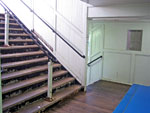 |
noyes10.jpg (183k) |
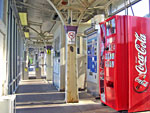 |
noyes11.jpg (306k) |
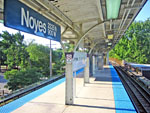 |
noyes12.jpg (332k) |
 |
noyes13.jpg (259k) |
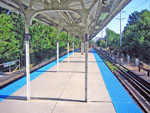 |
noyes14.jpg (364k) |
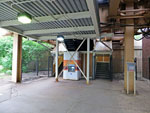 |
noyes16.jpg (234k) |
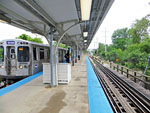 |
noyes20.jpg (290k) |
|
|